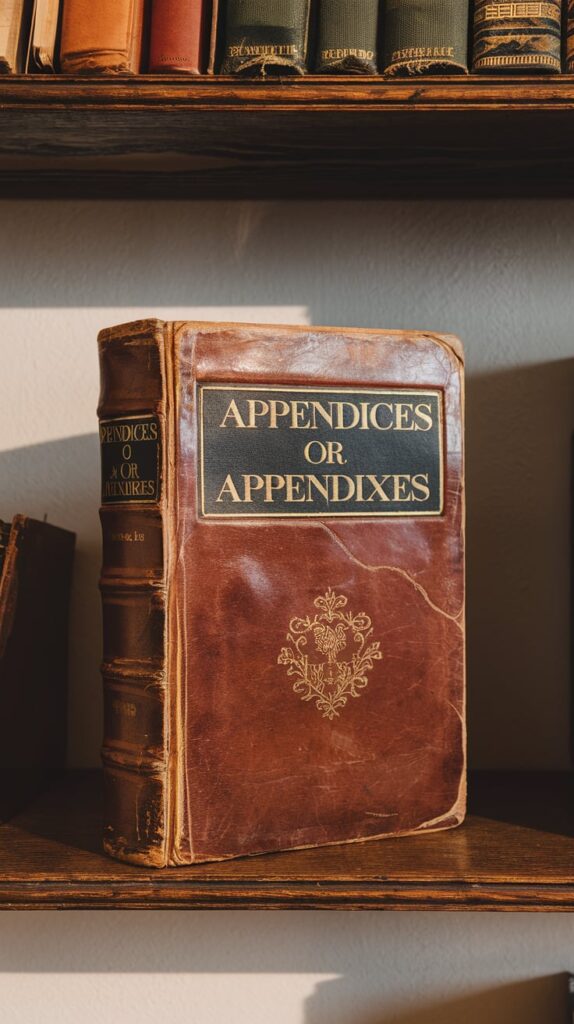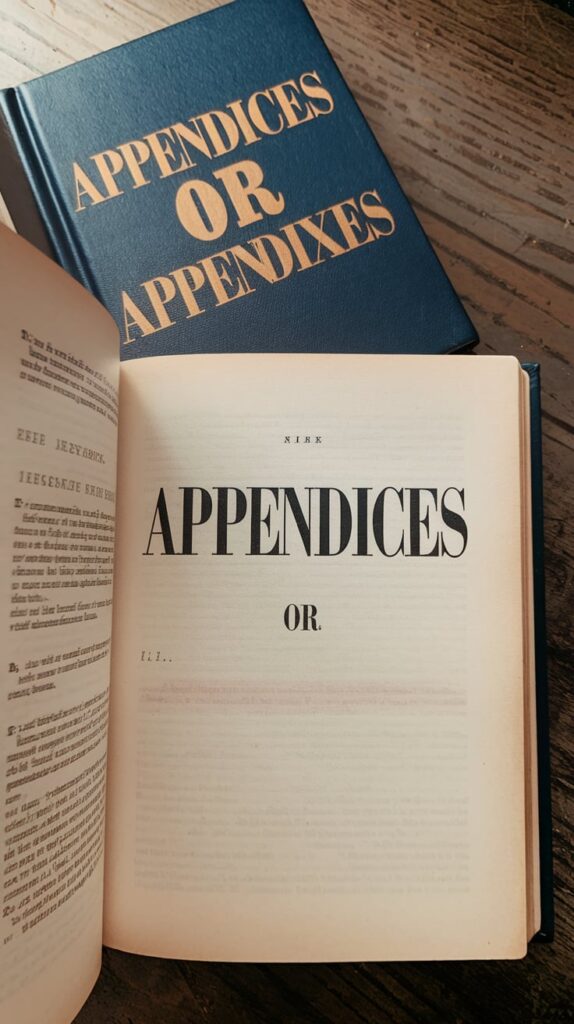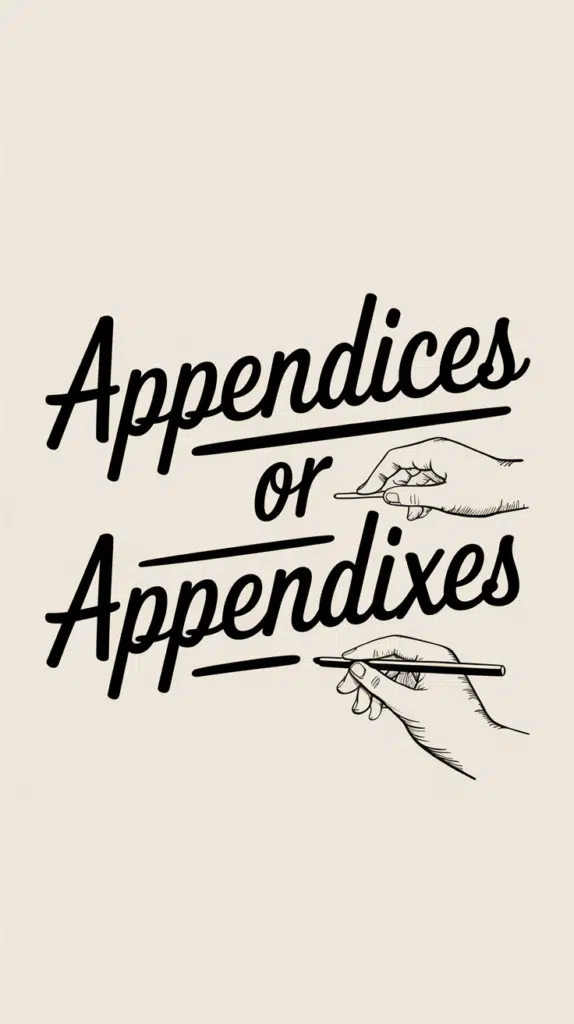Introduction
Navigating the intricacies of the English language can be a daunting task, especially when faced with terms that seem similar but have distinct usages. One such pair is “appendices” or“appendixes.”
Both terms refer to supplementary materials, yet many writers find themselves unsure of when to use each one. This comprehensive guide will clarify the usage of “appendices” or “appendixes,” providing examples.
like more : 15 Other Ways to Say “Enjoy Your Time Off” in an Email – Grammar Beacon

What do “Appendices” or “Appendixes” Mean?
Understanding the definitions of “appendices” or “appendixes” is crucial for anyone engaged in writing, whether for academic, professional, or casual purposes.
Both terms describe additional materials that accompany the main content of a document or book. These materials can include tables, charts, graphs, or detailed explanations, providing readers with deeper insights without interrupting the flow of the primary text.
Singular of “Appendices” or “Appendixes”
Before delving into the plural forms, it’s essential to establish the singular: “appendix.” This is the form you would use when referring to a single supplementary section.
For example, in a scientific report, you might say, “The appendix contains the raw data collected during the study.” This sets the foundation for understanding the distinctions between the plural forms.
Origins of the Word ‘Appendix’
The term “appendix” has its roots in Latin, originating from the word appendere, which translates to “to hang upon.” This etymology is fitting, as an appendix serves as an attachment to the main content,
providing additional information that is relevant yet separate from the primary narrative. Knowing the origin of the word can deepen your appreciation for its usage in modern contexts.
like more : Preform vs Perform – Grammar Beacon
Why Both “Appendices” or “Appendixes” Are the Plurals of ‘Appendix’
English is replete with inconsistencies, and the situation with “appendices” and “appendixes” exemplifies this phenomenon. Both forms serve as plurals for “appendix,” but their usage can vary based on the context:
- “Appendices” is often favored in academic or formal settings. For instance, in a dissertation, a student might state, “The research findings are detailed in the appendices.”
- “Appendixes” tends to appear in more casual or non-academic writings. You might encounter it in a blog post, where the author says, “For more information, refer to the appendixes at the end of the article.”
This duality allows writers flexibility, but knowing when to use each term can significantly improve your writing’s precision and professionalism.

“Appendices” or “Appendixes”: Where to Use Which One?
Choosing between “appendices” or “appendixes” often hinges on your audience and the document’s tone. Here are some guidelines to help you make the right choice:
In Academic Writing
When crafting scholarly articles, reports, or theses, it’s advisable to use “appendices.” This form conveys a sense of professionalism and adheres to academic conventions.
Example: In a thesis discussing environmental policies, you might say, “The data analysis is presented in several appendices to ensure clarity and thoroughness.”
In Casual Writing
For blog posts, articles, or informal content, “appendixes” is more commonly accepted. This form can create a conversational tone that engages readers.
Example: In a lifestyle blog about travel, you might write, “Don’t forget to check the appendixes for helpful travel tips and resources!”
When in Doubt
If you’re unsure which term to use, consider your audience and purpose. In professional settings, opt for “appendices,” while in casual contexts, feel free to use “appendixes.” Maintaining consistency in your choice throughout the document will enhance clarity.
Examples in Context
To further illuminate the usage of “appendices” and “appendixes,” let’s explore specific examples in various contexts.
Appendix: (Singular)
When referring to a single section, “appendix” is the appropriate term.
Example Scenario: Imagine you’re writing a research paper on social media effects. You might say, “The appendix includes survey questions that were used in the study.” Here, you clearly indicate that there is only one supplementary section.
like more : Vicious vs Viscous – Grammar Beacon

Appendices (Plural in Reference to a Book or Document)
In many published works, authors include multiple appendices to provide comprehensive information.
Example Scenario: Consider a textbook on computer science. It might state, “This book includes several appendices that cover programming exercises and additional resources for students.” This usage effectively communicates that there are multiple supplementary materials.
Appendices (Plural in Reference to Anatomy)
In the context of anatomy, the term “appendices” can refer to various appendages found in biological organisms.
Example Scenario: In a biology textbook, you might read, “The study explores the functions of different appendices in various species.” This highlights the term’s applicability beyond just written documents.
Here’s a revised summary table excluding the blogging tips:
| Aspect | Details |
| Definition | Additional materials attached to the main text. |
| Singular Form | Appendix |
| Plural Forms | Appendices (formal), Appendixes (informal) |
| Origins | Derived from Latin appendere meaning “to hang upon.” |
| Usage in Academic Writing | Prefer “appendices” for professionalism. |
| Usage in Casual Writing | Use “appendixes” for a conversational tone. |
| Examples of Usage | – Appendix: “The appendix includes data.” |
| – Appendices: “Several appendices are included.” | |
| Clarity and Precision | Essential for effective communication. |
| Best Practices for Appendices | Organize logically, use clear headings, reference in text. |
| Common Mistakes | Confusing plurals, neglecting audience expectations, overloading information. |
| Key Takeaways | Know your audience, maintain consistency, and format properly. |
This table succinctly captures the main points related to “appendices” or“appendixes.”
The Importance of Clarity and Precision in Writing
When writing, clarity and precision are paramount. Using terms like “appendices” and “appendixes” correctly can significantly impact how your message is received. Misusing these terms can lead to confusion and distract from the main points you wish to convey.
To ensure clarity in your writing:
- Know Your Audience: Tailor your language and terminology to suit your readers’ expectations and understanding.
- Be Consistent: Once you choose a term, stick with it throughout your document to avoid ambiguity.
- Use Contextual Clues: Provide context when introducing “appendices” or “appendixes” to ensure readers grasp their purpose in your writing.
Crafting Effective Appendices
When creating appendices for your documents, keep the following best practices in mind:
1. Organize Information Logically
Group related information together in your appendices. This helps readers find what they need quickly.
2. Use Clear Headings
Label each appendix clearly, using headings that describe the content within. This allows readers to navigate easily.
Example: Appendix A: Survey Questions
Appendix B: Data Analysis Tables
3. Reference Appendices in the Main Text
Don’t forget to direct readers to your appendices in the main body of your document. Use phrases like “see Appendix A” to guide them.
4. Keep it Relevant
Only include information in your appendices that directly supports your main text. Avoid overwhelming readers with excessive details that may distract from your core message.
5. Format Consistently
Ensure that the formatting of your appendices matches the overall style of your document. This includes font, spacing, and layout, which all contribute to a polished appearance.
A Final Look at “Appendices” or “Appendixes”
In summary, understanding the difference between “appendices” and “appendixes” is crucial for effective communication. By clarifying these terms, you can enhance your writing, engage your readers, and convey your message more effectively.
Both forms serve
as valuable tools in various contexts, from academic papers to casual blogs. By applying the guidelines outlined in this article, you can ensure that your writing remains clear, professional, and engaging.

Key Takeaways
- The singular form is “appendix.”
- “Appendices” is preferred in formal writing, while “appendixes” works well in casual contexts.
- Organize and format your appendices effectively to improve clarity.
By mastering these concepts, you’ll be well-equipped to use “appendices” and “appendixes” with confidence, boosting your writing’s clarity and professionalism.
Sources
- Merriam-Webster Dictionary
- Oxford English Dictionary
- Purdue Online Writing Lab (OWL)
With these insights, you’re prepared to tackle any writing project involving “appendices” or “appendixes.” Your readers will appreciate the clarity, and you’ll set yourself up for success in the vast world of writing!

James Logan is a seasoned blogger and language enthusiast behind Grammar Beacon. With years of experience in grammar and writing, James shares his expertise through insightful and engaging content. His passion for clear communication and linguistic precision shines in every post, making complex grammar concepts accessible and enjoyable for readers. Follow James for expert advice and tips to refine your writing skills.







